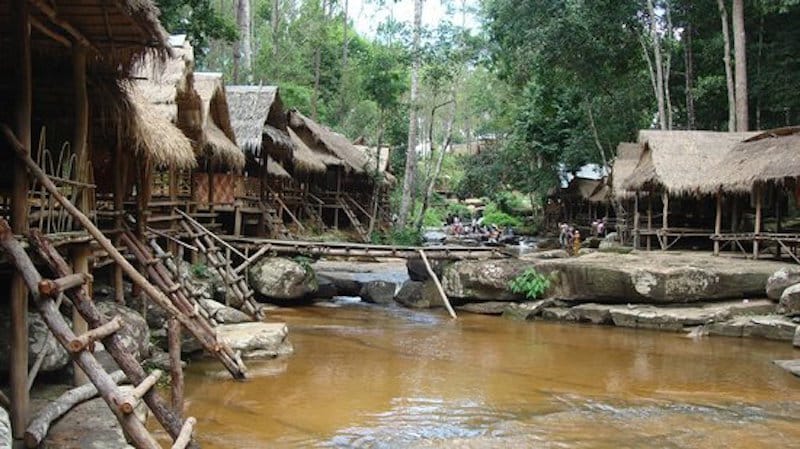Contents
KIRIROM NATIONAL PARK
The scenic Kirirom, which means “Happy Mountain,” is a mountain plateau and extends over the eastern part of the Cardamom Mountains at 800 meters above the sea and is composed of natural and semi-natural vegetation. The park boasts of an elevated pine forest, enchanting waterfalls, and lakes.
Getting to Kirirom National Park is a breeze. Located in the Kampong Speu Province, you just have to take a two-hour drive from Phnom Penh, either by bus or a shared taxi.
At Kirirom National Park, enjoy a breathtaking walk along the nature park’s numerous footpaths, or request a ranger to hike with you up to Phnom Dat Chivit, or “End of the World Mountain,” and get a stunning view of the western mountain ranges.
Apart from hiking, there are other leisure activities in Kirirom that you can choose from, such as ox-cart-riding, horse-riding, and bird-watching. You can also go canoeing, trekking, or simply enjoy a picnic or bathe in the bubbling streams that flow down from the mountain heights.
Kirirom is also popular for its abundance of endangered species and is home to the pileated gibbon, sun bear, tiger, Asian elephant, spotted linsang, wild ox banteng, and deer.
2. BOKOR NATIONAL PARK
From Kampot, rent a motorbike and enjoy the scenic ride to Bokor National Park, which tourist reviews over at tripadvisor describe as nothing short of dramatic. The 1581-sq-km national park is near the “Elephant Mountains” (a mountain range situated in south-western Cambodia), and consists of tropical jungles, waterfalls, and fresh mountain streams.
The park is also home to rare animals, which include the Indian elephant, the yellow-throated martin, leopard, Asiatic black bear, Malayan sun bear, slow loris, pig-tailed macaque, and the red muntjac deer. If you are a bird-watcher, then you will be impressed to know that the park has over 300 species of birds.
Famous for its once-abandoned French hill station, Bokor National Park also offers spectacular views of the oceans from 3000 feet, and you can also spend the night on the mountain top with beds available at the ranger station. You can arrange your own tour of the national park or you can stay at The Mad Monkey Hostel and enjoy a number of their Kampot adventure tours that will have you trekking through the forests to see the splendid waterfalls and the hidden caves of Bokor, not to mention the Bokor hill fort.
3. REAM NATIONAL PARK REAM
Located 18km from Sihanoukville City, which is about a half-an-hour ride, Ream National Park is a coastal park, where mini-adventures await you. You can delight on a boat trip through coastal mangroves, go snorkeling, enjoy a dolphin tour, safari tour, and walking tours in the misty jungles.
Comprising of the southeast of Prey Nob district of the Sihanoukville Province bordering the Gulf of Thailand, the park also encompasses beaches, coral reefs, islands, a river, mountains, and an estuary.
The Ream National Park is also popular for its pristine, untouched beaches, which is definitely a sanctuary if you are searching for a temporary escape from the hustle and bustle of city life.
The park is also home to endangered birds of prey, like the white-bellied sea eagle, the Brahminy kite, and the grey-headed fish eagle. You can also take pleasure in finding endangered birds in the park, such as the painter stork, the milky stork, and the lesser adjutant.
4. PHNOM KULEN NATIONAL PARK
Phnom Kulen National Park is located in the Phnom Kulen mountain massif in the Siem Reap Province. It is considered the most sacred mountain in Cambodia that contains ancient temples and carvings and what is deemed as a holy waterfall amidst the thick, luscious jungle.
Located in Svay Leu District about 48 km from the provincial town of Siem Reap or half a day trip, (about 25 km from Prasat Banteay Srey via Charles De Gaulle Road), Phnom Kulen National Park offers magnificent mountain scenery as a backdrop for its Buddhist temples, not like the usual ones you see in Angkor and includes the famous 16th century reclining Buddha carved into the mountain rock at the Wat Preah Ang Thom temple.
Nearby is the “Valley of 1000 Lingas” or “The River of a Thousand Lingas,” a site that contains a series of stone carvings sculpted from the sandstone formations in the river bed and banks. These are neatly arranged bumps with various Hindu mythological motifs. Tours for backpackers are also offered from The Mad Monkey Hostel in Siem Reap to Phnom Kulen.
Add a refreshing dip at its famous waterfall to your itinerary and Phnom Kulen will surely make it one of your trip’s most relaxing experiences.
A professional guide who knows all the history and stories behind the temple, the Reclining Buddha, the Linga River, and the waterfalls will definitely add a more enriching experience to your trip.
All of the five parks generally offer the same fresh, exhilarating, and exotic experience: the lush greenery, the wildlife, the peace and quiet, the spectacular views, and the mini-adventures. It’s just a matter of choosing what’s best for your budget and time. Please never walk un-escorted in any of the parks, like Vietnam there are still landmines scattered throughout jungle brush and un-exploded ordinance so always make sure you depart with a local guide that knows the area.
Mad Monkey Hostels operates in the following Cambodian locations: Phnom Penh, Siem Reap, Kampot, Koh Rong Samloem



